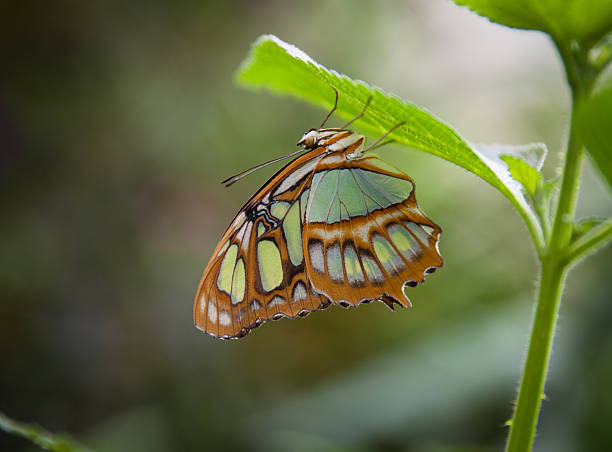ANIMAL: Malachite Siproeta stelenes Type of Animal: Brush-Footed Butterfly Habitat: Orchards, fruit/avocado groves, plantations, subtropical evergreen forest, semi-deciduous forest, deciduous forest, clearings, forest margins, tropical hammocks Location(s): Ranges from S Texas & S Florida through Caribbean islands, Mexico, & Central America all the way S to Brazil Appearance: Large wings black & brilliant green/yellow-green on upperside, light brown & olive green on underside, caterpillars horned/spiny/black w/ red markings, green pupa w/ sharp gold spines. Summer form has silver markings in orange marginal band in hindwing underside, winter form has smudged black marks instead of silver marks & larger than summer form. Food/Diet: Adults eat rotting/overripe fruit, nectar, tree flowers, bird poop, bat poop, herbaceous plants, & carrion. Caterpillars eat herbaceous plants. Status in Wild: Stable Conservation: Breeding in butterfly gardens, zoos, aquariums, & museums Lifestyle: Found in small groups Additional Info: Called: Male Female Young: Caterpillar Group: Flutter Gestation: 6-7 days Life Span: Summer form: 6-7 weeks Winter form: 8-9 months Body Length/Wingspan: Male: 2.5-2.75 in Female: 3-4 in Caterpillar: 2.5 in Females lay eggs singly on variety of herbaceous plants (especially Acanthus species). Caterpillars hatch after 6-7 days & stay in that stage for 1-4 weeks. After caterpillar stage, they enter pupa/chrysalis stage when they shed outside layer of skin & attach to leaf/branch. This stage can last from 6 days to as long as 9 months, depending on form. Winter form has much longer pupa/chrysalis stage. Adults only live 1-2 weeks, w/ males dying after mating & females dying after laying eggs. When adults leave chrysalis, they wait a few hours for wings to dry & fill w/ blood before taking 1st flight. Often bask in sun w/ wings open to gain heat. Two antennae on top of head help butterfly smell/hear/feel. These butterflies often confused w/ Dido Longwing (which they share much of range with) due to green coloration. The 2 species have different wing shapes & Dido Longwings have longer wingspan & different coloration on underwings. Active during the day (diurnal). Most of their day is spent feeding. Adults roost together under leaves. Summer form has 3-4 generations while winter form has 1 generation. Fun Fact(s): These butterflies can’t fly or eat if body temp is below 82 F. Gets name from mineral malachite which has same shade of green. These butterflies can fly as high as 38 ft.
